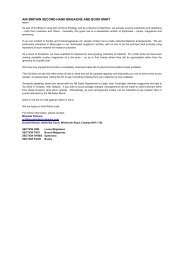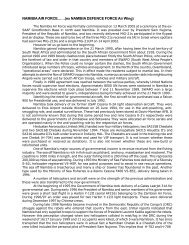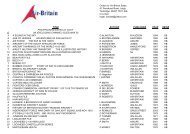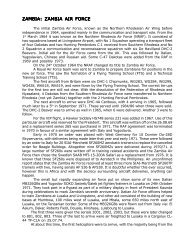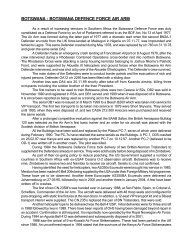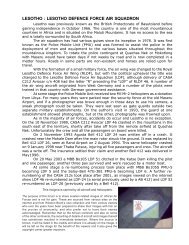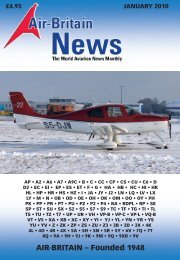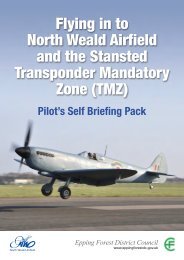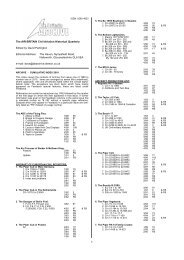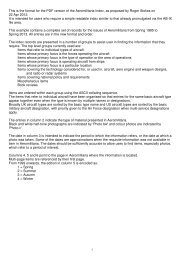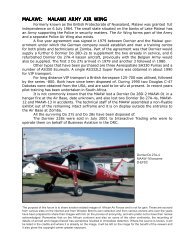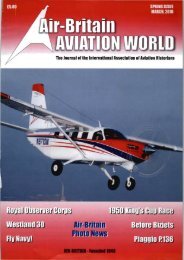The AIR-BRITAIN Militarv Aviation Historical Quanerlv
The AIR-BRITAIN Militarv Aviation Historical Quanerlv
The AIR-BRITAIN Militarv Aviation Historical Quanerlv
Create successful ePaper yourself
Turn your PDF publications into a flip-book with our unique Google optimized e-Paper software.
A view of a P.74 model shown at a Farnborough Show, with a fin (incorporating a rudder) in lieu of a tail rotor.<br />
(Percival Aircraft PY3509 via Mike Hooks)<br />
<strong>The</strong> P.74, Percival's first attempt at a helicopter design, was<br />
schemed to meet Specification EH.125D, which called for an<br />
experimental helicopter to conduct ground and flight tests of a<br />
rotor driven by jets at the blade tips. <strong>The</strong> jets were to be<br />
supplied with gas from a fuselage-mounted gas generator.<br />
<strong>The</strong> Specification, which was issued on 08May1952, called for<br />
the prototype to be fitted with stub wings to relieve the rotor of<br />
aerodynamic loads in flight, but the final design did not have<br />
wings. Conveniently, the chosen power plant consisted of<br />
two Napier N.Or.1 Oryx (Napier .E.164) gas generators<br />
(convenient because Percival's Luton works was immediately<br />
adjacent to D. Napier & Sons' Flight Test Department, where<br />
Napiers had already built a helicopter-rotor test facility). This<br />
facility was also used to try out experimental gas generator<br />
systems, and was also used for ground running of the<br />
prototype P.74. <strong>The</strong> single prototype was issued with the Air<br />
Ministry serial number XK889 on 120ct1955, under Contract<br />
No. 6/Aircrattl7054/CB.9(b).<br />
XK889 was rolled out May 1956 for engine runs without the<br />
rotor, and later tests were made with the rotor fitted . <strong>The</strong><br />
Specification called for an extensive ground test schedule<br />
prior to any flight tests. When the flight test stage was<br />
reached, the aircraft failed to fly due to the un-powered cyclicpitch<br />
controls being unable to overcome system inertia,<br />
despite the heroic efforts of two pilots attempting to obtain liftoff.<br />
A 'P.74 Mk.II' with an RB.108 engine and redeSigned rotor<br />
Aeromilitaria - Winter 2010<br />
system (with hydraulic power for the cyclic pitch controls) was<br />
proposed as the Percival P .113, but this came too late to save<br />
the project, which was cancelled and the prototype sent for<br />
scrap. As originally schemed, the P.74 had a large<br />
conventional fin, but it was found necessary to provide the<br />
complication of a tail-rotor on the aircraft, thereby partly<br />
negating one of the claimed design benefits, which was of the<br />
system simplification to be achieved by eliminating rotor drive<br />
shafts and gearboxes. As already mentioned, the rotor was<br />
driven by hot gas ducted from the engines through to the main<br />
rotor blades and ejected at the blade tips. <strong>The</strong> rotor blades<br />
were of a laminar-flow cross-section.<br />
Doubts about the success of the original concept had led to<br />
earlier revised proposals under the design numbers P.104 and<br />
P.105, but these did not proceed because of confidence -<br />
misplaced as it turned out - that the P.74 would fly<br />
successfully. <strong>The</strong> P.104 was essentially the P.74 with<br />
conventional (non-Iaminar-flow) rotor blades and powered<br />
cyclic-pitch controls, while the P.1 05 was a more fundamental<br />
redesign with a different arrangement of the gas-generating<br />
units and gas vents. <strong>The</strong> P.74 gas vents, shown in one of the<br />
photographs, ejected hot gases at ground-level while the<br />
engines were running but when no gas was being directed to<br />
the rotor - very hot and dangerous for the ground personnel -<br />
while the proposed P.105 would have had the Oryx engines<br />
and gas vents above the cabin.<br />
167




